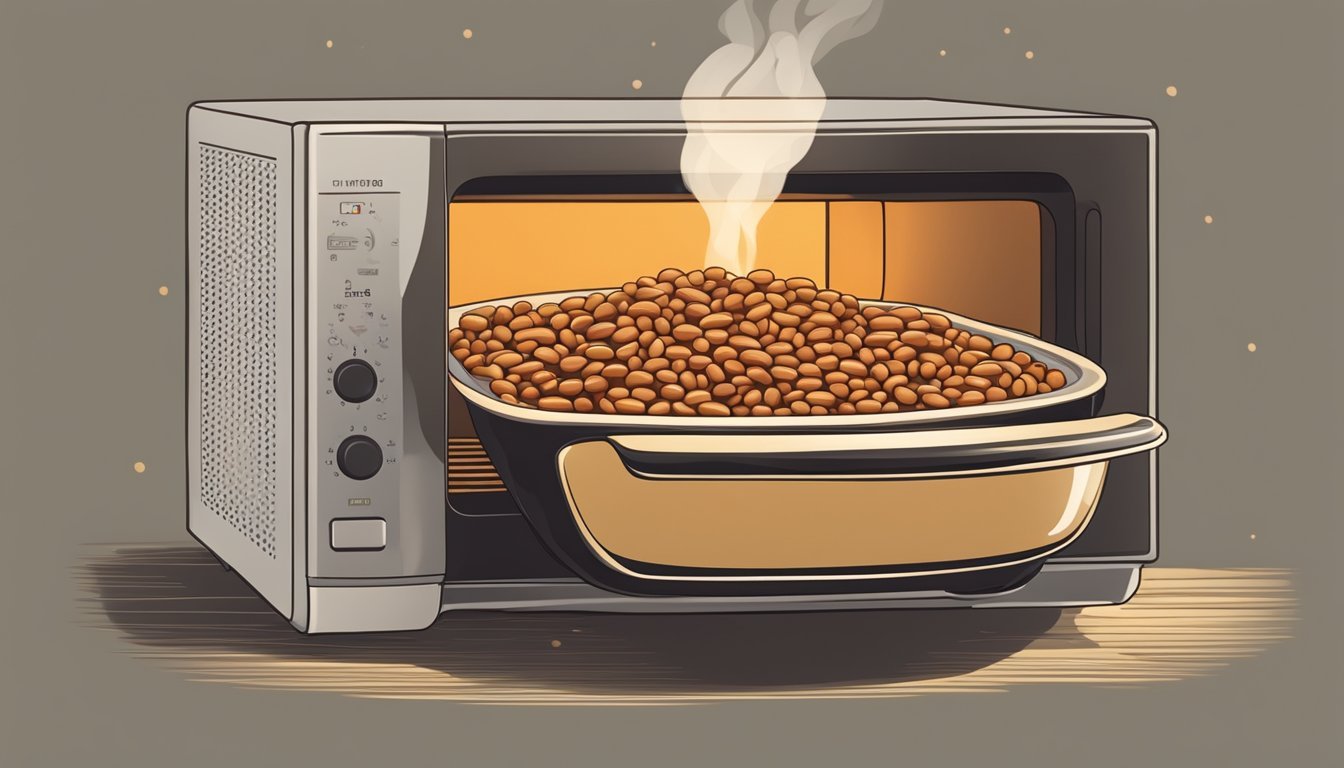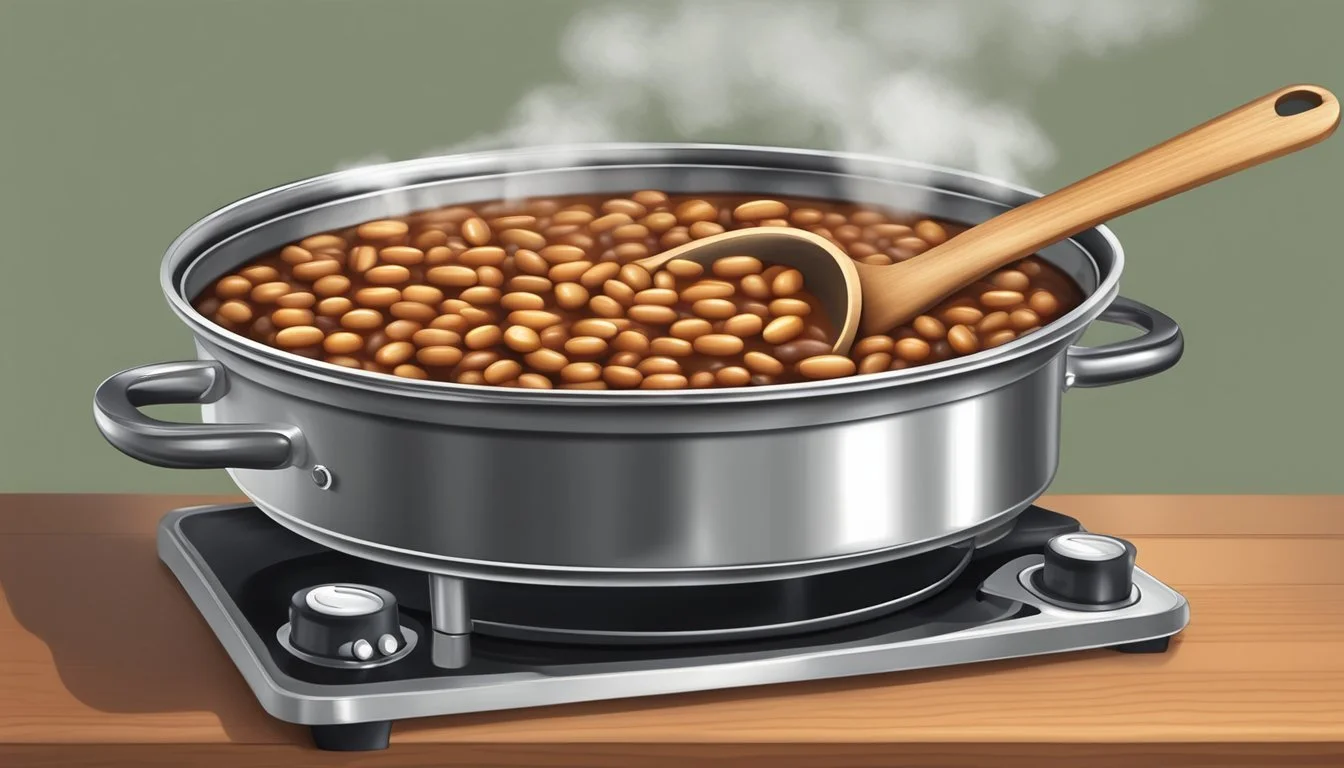Best Way to Reheat a Baked Bean Dish
Tips for Perfect Texture Every Time
Reheating baked beans is a common necessity, whether one is enjoying leftovers or preparing a make-ahead meal. The key to retaining the flavor and texture of the original dish lies in the chosen reheating method. Baked beans are best when they are hearty and infused with a depth of flavor, but they can easily become mushy if not handled properly during reheating. To preserve the desired consistency and taste, it is crucial to use techniques that reheat the dish evenly without overcooking the beans.
One of the most effective methods to reheat baked beans without compromising their texture is to use an oven. This technique allows for a gentle and uniform heat distribution. It is recommended to preheat the oven to a moderate temperature, around 350°F (175°C), before placing the beans in an oven-safe dish. To prevent the beans from drying out, one can introduce a small amount of water or broth and cover the dish with foil. This precaution helps maintain the right moisture level, keeping the beans succulent.
Another aspect to consider while reheating beans is the duration and frequency of stirring. Stirring at intervals ensures the heat reaches all parts of the dish, averting the mushiness that comes from beans sitting in one position for too long. The overall goal is to achieve a warmed-through dish where the beans remain intact, and the flavors are as robust as when they were first baked. With a measured approach, it is possible to enjoy reheated baked beans that are just as satisfying as the freshly made version.
Understanding Reheating Baked Beans
The reheating process is crucial to maintain the flavors and textures of baked beans while ensuring they are safe to consume.
Importance of Proper Reheating
Reheating baked beans correctly is essential to preserve their quality and taste. Leftover baked beans should be heated to the right temperature to ensure they are warm throughout without becoming mushy. An ideal temperature is often around 350°F (175°C), allowing for a gentle warming. It is recommended to add a small amount of water or broth to baked beans before reheating to keep them moist. Beans should be stirred occasionally to ensure even heat distribution.
Reheating and Food Safety
Safety is paramount when reheating any leftovers, including baked beans. To reduce the risk of food-borne illnesses, beans should reach an internal temperature of 165°F (74°C). Covering the dish with foil can prevent drying out and help evenly distribute the heat. If using a microwave, covering the beans with a microwave-safe lid or plastic wrap is equally important for safety and preventing splatters. Leftovers should be refrigerated within two hours of cooking and consumed within three to four days to ensure they remain safe to eat.
Preparing Baked Beans for Reheating
Proper preparation is essential for ensuring that baked beans retain their flavor and texture when reheated. The key considerations involve how they are stored initially and the process for thawing if they’ve been frozen.
Storing for Freshness
To maintain the quality of baked beans, they should be stored in an airtight container in the refrigerator if they are to be reheated within a few days. This limits exposure to air and bacteria, which can degrade flavor and cause spoilage. If the beans won't be consumed within four days, freezing is recommended.
Storage Steps:
Allow the baked beans to cool to room temperature.
Transfer beans to an airtight container.
Seal the container and label with the date.
Place in the refrigerator for short-term storage or in the freezer for long-term.
Thawing Frozen Baked Beans
For baked beans that have been frozen, a gradual thaw in the refrigerator ensures that the beans remain intact and prevents the texture from becoming mushy.
Thawing Guidelines:
Transfer the container of baked beans from the freezer to the refrigerator.
Allow them to thaw for several hours or overnight.
Once thawed, the beans are ready to be suitably reheated.
Reheating Methods Compared
Reheating baked beans properly is crucial to maintaining their texture and flavor. This section compares different methods, focusing on preserving quality while achieving even heating.
Oven Reheating Method
Preheat the oven to 350°F before starting. To reheat baked beans in the oven:
Transfer the beans into an oven-safe dish.
If the beans appear dry, add a small amount of water or broth to maintain moisture.
Cover the dish with aluminum foil to prevent the beans from drying out.
Place in the oven and reheat for approximately 20-25 minutes.
Stir halfway through the heating process to ensure even heating.
Stovetop Reheating Method
For the stovetop method:
Place the beans in a pot on the stove over medium heat.
Stir occasionally to prevent the beans from sticking and to promote even warmth.
If necessary, add a little water or sauce to adjust the moisture level.
Microwave Reheating Method
When using a microwave to reheat baked beans:
Place beans in a microwave-safe container.
Cover the container, using a microwave-safe lid or wrap, to avoid splattering.
Heat on high power in short intervals, stirring in between to ensure even heating.
Be cautious to not overcook as this can lead to mushy beans.
Slow Cooker Reheating Method
For a gentle reheat using a crockpot or slow cooker:
Place the baked beans into the slow cooker.
Set on low to prevent beans from becoming mushy.
Stir occasionally, and monitor the moisture level, adding liquid as needed.
By following these methods, one can achieve warmed baked beans that retain their original quality and consistency.
Best Practices for Reheating Baked Beans
Reheating baked beans requires careful temperature control and methods to preserve their texture and flavor. Here, one will learn the most effective ways to reheat baked beans while avoiding common pitfalls that lead to subpar results.
Maintaining Ideal Texture
To prevent baked beans from becoming mushy, it is essential to reheat them gently at a moderate temperature. An oven temperature of 350°F (175°C) is recommended. Here's a step-by-step guide:
Preheat the oven to the indicated temperature.
Place beans in an oven-safe dish, adding a little water or broth if they appear dry.
Cover the dish with a lid or aluminum foil to create a vent and retain moisture.
Stir the beans occasionally during heating to ensure even warmth throughout.
This method allows the beans to reach the desired temperature without overcooking, which maintains their ideal texture.
Retaining Maximum Flavor
Flavor retention hinges on both the reheating process and the additions made to the beans. To enhance taste without overwhelming the original seasoning profile, consider the following:
Add seasonings sparingly: A little brown sugar or mustard can help revitalize flavor.
Incorporate cooked onions or bacon: If the original dish contained these ingredients, adding them fresh during reheating can refresh the dish’s savory qualities.
Stir carefully: This mixes the seasonings evenly and helps distribute flavors.
By adjusting seasonings and ingredients with a light hand, one ensures that the reheated beans taste as good as when they were first cooked.
Preventing Beans from Becoming Mushy
A key aspect when reheating beans is to avoid stirring them too vigorously or too often, as this can break the skins and cause a mushy consistency. Instead, one should:
Continuously stir with care: Only do so gently to mix flavors without damaging the beans.
Monitor the moisture level: If the beans start to dry out, add water one tablespoon at a time. A moist environment helps keep the beans intact.
Use a low and slow approach for reheating: If using a stove, a medium heat with frequent checks is prudent.
By following these steps, the beans will warm through without losing their firmness, ensuring a pleasant texture in every bite.
Serving Reheated Baked Beans
Once the baked beans are properly reheated, they should be served immediately to ensure the best taste and texture. Temperature and consistency are key factors to a satisfying dish.
Presentation: Serve the beans in a pre-warmed bowl or dish to maintain their heat.
Accompaniments: Pair with sides like toasted bread or a green salad for a balanced meal.
Temperature and Consistency
It is crucial that the beans are not too hot or too cold. They should be warm enough to enjoy, but not so hot as to cause discomfort. The beans should also retain their original consistency, being neither too thick nor too runny.
Warmth: Ensure the beans reach a temperature that is pleasant to eat.
Consistency: Check that the beans are neither too dry nor too mushy.
Portioning
Use a serving spoon to distribute the beans, ensuring each portion has an equal amount of sauce and beans.
Equal Portions: Spoon out balanced servings for each plate.
Sauce: Make sure there's enough sauce to avoid the beans drying out on the plate.
By paying attention to these details, reheated baked beans can be just as enjoyable as when they were first made. The goal is to provide a dish that is rich in flavor and perfect in texture, making for a delightful dining experience.
Additional Tips and Tricks
To maintain the quality of baked beans upon reheating, one must consider not just the reheating method but also the way the dish is stored and served afterward. Here, specific guidance tailored to baked beans will help ensure the dish retains its delicious flavor and texture.
Using Leftovers Creatively
Leftover baked beans can serve as more than just a simple reheated side. They can be incorporated into new dishes to enhance their flavor profile. For instance, Heinz baked beans can become a hearty component in casseroles or as a base for a bean soup. It's important to store leftovers correctly by placing them in an airtight container and refrigerating promptly.
Adjusting Seasonings After Reheating
After reheating, one may sometimes find the flavors in baked beans have altered. A touch-up of seasonings can rectify this. It may be beneficial to add a pinch of salt or a dash of your favorite spice blend to rejuvenate the dish. Homemade baked beans often respond well to this adjustment, as the complex flavors can settle differently after storage.
Reheating Canned vs. Homemade Baked Beans
Canned and homemade baked beans have different considerations when reheating:
Canned Beans: When reheating canned beans like those from Heinz, one must ensure not to overheat as it may cause the beans to become mushy. It's better to use a medium heat level and check frequently.
Homemade Baked Beans: Homemade varieties often contain ingredients that may separate or absorb more liquid upon cooling. It's recommended to add a small amount of water and cover with aluminum foil or plastic wrap during oven reheating to retain moisture.
By applying these additional tips, baked beans can be reheated successfully without compromising their integrity and taste.
Frequently Asked Questions
How long should one reheat baked beans?
Oven: Reheat baked beans in a preheated oven at 350°F for about 10 minutes.
Microwave: Heat in a microwave-safe container for 1-2 minutes on high, stirring occasionally.
Skillet: In a skillet over medium heat, reheat beans for 1-2 minutes.
What's the best method to reheat baked beans without them getting mushy?
Oven: Gentle reheating in an oven, covered with foil to retain moisture.
Skillet: Careful stirring over medium heat, adding water if necessary.
Are there any tips for reheating baked beans in the microwave?
Reheat in a microwave-safe container, preferably covered with microwave-safe plastic wrap. Stir occasionally and add a tablespoon of water if they appear dry.
Is it necessary to add liquid when reheating the beans?
It's advisable to add a small amount of water or broth if the beans seem too thick, to help restore moisture without making them mushy.
What type of container should one use to reheat beans?
Oven: An oven-safe dish.
Microwave: A microwave-safe container.
Skillet: Any skillet will do, as long as it's suitable for the heat source you're using.





